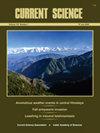Structural characterization of a putative recombinant l-amino acid oxidase from Leptospira interrogans
IF 1.1
4区 综合性期刊
Q3 MULTIDISCIPLINARY SCIENCES
引用次数: 0
Abstract
Amino acid oxidases (AOs) are flavin adenine dinucleotide (FAD)-dependent dimeric enzymes that stereo specifically catalyse the deamination of an -amino acid leading to an -keto acid. Putative Leptospira interrogans recombinant L -amino acid oxidase ( Li -rLAO; lacking 20 residues corresponding to the N-terminal signal sequence) was cloned, expressed, purified, and i ts three-dimensional structure was determined by X-ra y crystallography at a resolution of 1.8 Å. The active site could be easily identified by the presence of electron density corresponding to a non-covalently bound FAD in both protomers of the dimeric enzyme. Structural analysis of Li- rLAO revealed that its polypeptide fold is similar to those of the previously determined homologous structures as available in the Protein Data Bank. However, a substrate-binding residue found at the activ e site of other previously determined homologous structures was not conserved in Li- rLAO, suggesting that its specificity may differ from those of earlier reported structures. Not surprisingly, Li- rLAO showed no activity for most amino acids and amines; it exhibited a low activity only with L -arginine as the substrate. The cata-lytic properties of Li- rLAO could be rationalized in terms of its three-dimensional structure.可疑钩端螺旋体重组l-氨基酸氧化酶的结构表征
氨基酸氧化酶(AOs)是黄素腺嘌呤二核苷酸(FAD)依赖的二聚体酶,其立体特异性催化-氨基酸脱胺生成-酮酸。推定钩端螺旋体重组L -氨基酸氧化酶(Li -rLAO;缺失20个与n端信号序列对应的残基)进行了克隆、表达、纯化,并通过分辨率为1.8 Å的X-ra - y晶体学测定了其三维结构。通过在二聚体酶的两个原聚体中存在与非共价结合的FAD相对应的电子密度,可以很容易地识别活性位点。Li- rLAO的结构分析表明,其多肽折叠与先前在蛋白质数据库中确定的同源结构相似。然而,在Li- rLAO中,在其他先前确定的同源结构的活性位点发现的底物结合残基并未保守,这表明其特异性可能与先前报道的结构不同。不出所料,Li- rLAO对大多数氨基酸和胺没有活性;仅以L -精氨酸为底物时活性较低。Li- rLAO的催化性质可以从其三维结构来解释。
本文章由计算机程序翻译,如有差异,请以英文原文为准。
求助全文
约1分钟内获得全文
求助全文
来源期刊

Current Science
综合性期刊-综合性期刊
CiteScore
1.50
自引率
10.00%
发文量
97
审稿时长
3 months
期刊介绍:
Current Science, published every fortnight by the Association, in collaboration with the Indian Academy of Sciences, is the leading interdisciplinary science journal from India. It was started in 1932 by the then stalwarts of Indian science such as CV Raman, Birbal Sahni, Meghnad Saha, Martin Foster and S.S. Bhatnagar. In 2011, the journal completed one hundred volumes. The journal is intended as a medium for communication and discussion of important issues that concern science and scientific activities. Besides full length research articles and shorter research communications, the journal publishes review articles, scientific correspondence and commentaries, news and views, comments on recently published research papers, opinions on scientific activity, articles on universities, Indian laboratories and institutions, interviews with scientists, personal information, book reviews, etc. It is also a forum to discuss issues and problems faced by science and scientists and an effective medium of interaction among scientists in the country and abroad. Current Science is read by a large community of scientists and the circulation has been continuously going up.
Current Science publishes special sections on diverse and topical themes of interest and this has served as a platform for the scientific fraternity to get their work acknowledged and highlighted. Some of the special sections that have been well received in the recent past include remote sensing, waves and symmetry, seismology in India, nanomaterials, AIDS, Alzheimer''s disease, molecular biology of ageing, cancer, cardiovascular diseases, Indian monsoon, water, transport, and mountain weather forecasting in India, to name a few. Contributions to these special issues ‘which receive widespread attention’ are from leading scientists in India and abroad.
 求助内容:
求助内容: 应助结果提醒方式:
应助结果提醒方式:


